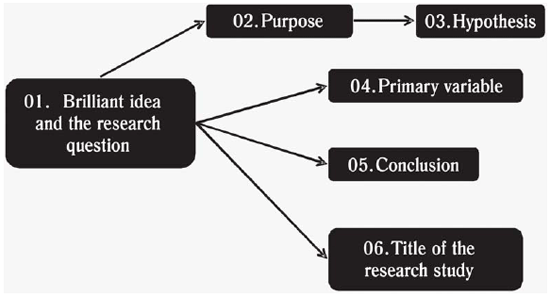INTRODUCTION
When participating in evaluations of scientific articles, the works of scientific initiation, end-of-course assignment, the boards of master's degree dissertation or doctorate thesis, we always focused on the main components of these works, by understanding as the most important, "
the brilliant idea and the research question", the "
hypothesis", the "
purpose of the study", the "
primary variable", the "
conclusion" and the "
title of the research study", composing "
The Magic Sextet of Clinical Research" (Figure 1), that means the "alignment", or that is, the direct and consecutive relationship between steps of the scientific publication.

Fig. 1 - "The Magic Sextet of Clinical Research"
These important components are [1]:
1. The "
Brilliant idea and the research question";
2. The "
Hypothesis";
3. The "P
urpose of the study";
4. The "
Primary variable";
5. The "
Conclusion" and
6. The "
Title of the research study".
These are important factors, and they must be well aligned and present in the disclosure of research, both as an end-of-course alignment, scientific article, master's degree dissertation or doctoral thesis, and mean a great step for an appropriate scientific study and the possibility of publishing of the original article in a scientific journal of proven quality.
Currently, there is a demand for quality of these articles by these scientific journals for acceptance for publication, since they are being subjected to increased criteria of demands for evaluation by CAPES (Coordination for the Improvement of Higher Level Personnel) for classification and qualification and by SciELO (Scientific Electronic Library Online) for online publication of these scientific articles [2].
All these components of "
Magic Sextet of Clinical Research" participate in clinical research and its publication.
Clinical research is a class of activities that uses human beings and animals for experimentation as analysis units, whose objectives are development and contribution to the knowledge that can be applied in patients or healthy individuals in similar clinical conditions [3].
Such researches have results that may corroborate or contradict directly clinical practice by using clinical irrefutable variables [3].
Clinical research is important for generation of knowledge, publication of results and contribution to public health of our country. It is also important for those already familiar with this methodology, by providing update and awakeness to new themes, behaviors and learning of their graduate and postgraduate students [4].
It is up to the physician the interpretation of these results to apply them to their patients. The ideal would be that all clinical researches would be perfect, so that we would not have to worry about their quality and we could, in the decision making process, use the confidence interval of 95% of their results [3].
HOW DO WE PERFORM THE CLINICAL RESEARCH?
To perform a scientific research, we must start from three basic prerequisites [4]:
1. Knowing well and to be competent in the subject to be researched;
2. Having access and control the sample;
3. Depending on the minimum possible of third parties to perform the research.
We also should appreciate the scientific method and feel motivated for the learning that we may have during this learning process of the clinical or experimental research [4].
The accomplishment of the scientific research and subsequent publication of the results through original article in scientific journal begin with the brilliant idea that we may have from the research question we want it answered.
For example, if we want to know which is the best method for treatment of the thoracic-abdominal aortic aneurysms: open surgery or endovascular treatment, we should propose a scientific study to answer this question, starting from the "
brilliant idea and the research question", proposing a "
hypothesis and a purpose of the research", according to the plan of intent, review of literature, instruments and procedures tests, finishing with the research project, which contains the proposed "
primary variable", corresponding to:
a) first stage of research planning, followed by:
b) second phase of research accomplishment finished with the final report and;
c) third stage of research disclosure, mainly in the form of original article publication [4].
Each research will be composed of three phases: planning, accomplishment, disclosure, consisting the research steps [3] (http://www.metodologia.org/pesquisa) resuting in the publication that will be the contribution of the author or authors to the disclosure of scientific knowledge.
CONCLUSION
When we are called to evaluate scientific studies, we always note the presence of "
The Magic of Sextet of Research" as a starting point for the beginning of this evaluation. If present, such sextet represents a good initiation of the clinical research and appropriate structuring of the course conclusion paper, scientific article, master's degree dissertation and doctorate thesis.
1. Castro AA. Fiat lux. Maceió:Universidade Estadual de Ciências da Saúde de Alagoas;2006. Disponível em: URL:http://www.metodologia.org/livro.
2. Braile DM. RBCCV caminha para a digitalização total. Rev Bras Cir Cardiovasc. 2008;23(4):I-II. View article
3. Castro AA, coord. Programa minha primeira pesquisa. Maceió:Universidade Estadual de Ciências da Saúde de Alagoas;2006. Disponível em: URL:http://moodle.uncisal.edu.br.
4. Pitta GBB, Castro AA. A pesquisa científica. J Vasc Bras. 2006;5(4):243-4.

 All scientific articles published at rbccv.org.br are licensed under a Creative Commons license
All scientific articles published at rbccv.org.br are licensed under a Creative Commons license